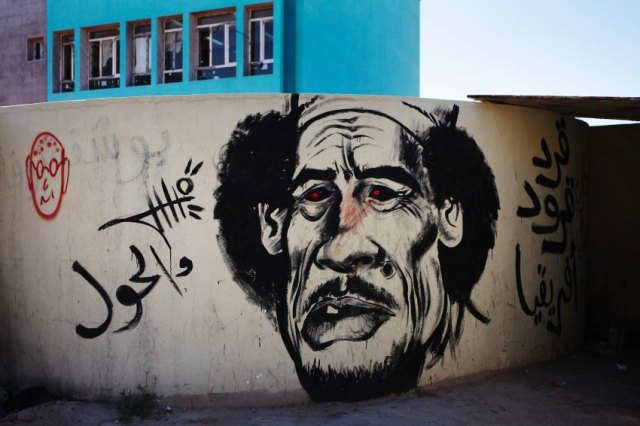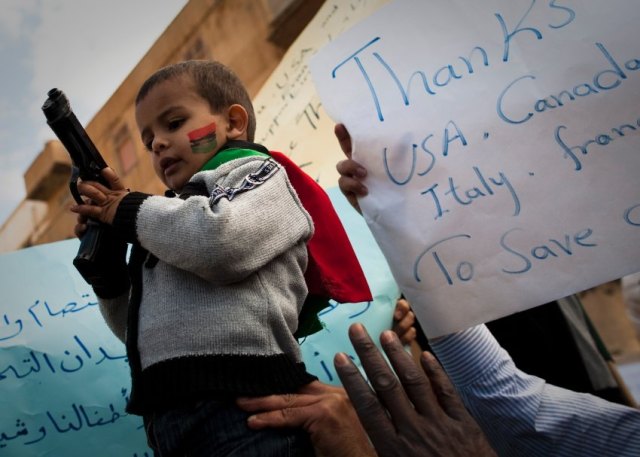Update: I have written an article on this subject which can be downloaded here. See here for an abstract. Comments and feedback are very much welcome!
****************************************
I have wondered for some time now about the relationship between the ICC and the Responsibility to Protect (R2P). The reason is pretty simple – prior to concentrating on the ICC during my masters studies, my academic focus and interests was on R2P. I felt that there was an affinity between the two concepts as well as important threads or narratives that linked them. No work that I know of has systematically examined the practical, political and ethical relationship between R2P and the ICC. This post represents an effort to try to wrestle with and illuminate the potential links between the two in practice, politics and ethics.
As many readers will know, the R2P doctrine asserts that the international community has the responsibility to intervene in a sovereign state if that state is unwilling or unable to prevent or stop genocide, war crimes, ethnic cleansing and crimes against humanity. As a concept, it was developed by the International Commission on Intervention and State Sovereignty (ICISS) in the wake of controversy over the humanitarian intervention in Kosovo and the question of whether a “right to intervene” existed. In 2005 with some modifications (tethering it to the UN Security Council, for example), R2P passed unanimously as a resolution at the UN’s General Assembly.
In 1998 the international community agreed to set up the ICC which subsequently came into being in 2002. The Court’s mission is to end impunity by holding individuals who are “most responsible” for war crimes, crimes against humanity, and genocide accountable. It currently has six states under official investigation and a handful of cases are being heard at its headquarters in the Hague, Netherlands.
The precise relationship between the ICC and R2P has rarely been made explicit or clear. In a recent discussion about the two concepts, Benjamin Schiff says that getting to the bottom of the relationship is “irritating”. Nevertheless, there seems to be an increasing recognition that these two concepts – typically considered separately – are, in fact, intimately linked.
Before looking at Schiff’s arguments of the practical relationship between the two concepts as well as mine on the political and ethical underpinnings of both R2P and the ICC, let’s consider some broader possible links.
First, typically those groups and individuals who support ICC, support R2P and vice versa (see the Enough! Project, for example). Likewise, those who are suspicious of the ICC will almost surely be suspicious about R2P (we all know what John Bolton thinks!) Sure, context will determine when either is supported or not, but this suggests that there’s some subtext that bridges the ideas behind R2P and ICC.

Rebel fighters in Benghazi. Where the language of R2P has been invoked the langauge of international criminal law has never been far behind (Photo: Reuters)
Second, while many consider R2P a doctrine of humanitarian military intervention, in actuality, it is much broader than that. It is a doctrine based on a continuum of responses along which legal action or the threat of legal action to stop or prevent atrocities has a place.
Third, when the rhetoric of R2P is invoked, the language of international criminal justice is rarely far behind. Libya is a case in point. The language of responsibility for protecting Libyan civilians paralleled the language of bringing Gaddafi to account for alleged crimes against humanity. Even when the language of R2P was not explicitly employed as in Resolution 1970 which referred the situation in Libya to the ICC, the basic tenets of R2P were at play. One observer remarked:
“R2P is not mentioned in the resolution [1970]: nonetheless, its flavour impregnates the decision. In referring the situation to the ICC, and thus sending a clear signal to unscrupulous leaders that their crimes will not go unpunished, the UN Security Council brings the responsibility to protect to the forefront of the battle to maintain international peace and security in the world.”
All of this suggests a proximity of the concepts and institutions of R2P and the ICC. But it doesn’t illustrate the nature or foundation of the proximity.
Schiff argues that there are numerous similarities between R2P and the ICC. Both are products of the 1990s but have genealogies which stretch back further into history. Each address similar governmental failures, namely the failure (or unwillingness) of governments to prevent atrocities. Both thus speak to the responsibilities that governments have to their citizens and imply that when governments fail or are unwilling to uphold those responsibilities, external interventions are warranted. Interestingly, with the exception of ethnic cleansing and aggression, R2P and the ICC also cover the same crimes – crimes against humanity, war crimes, and genocide. Both R2P and the ICC thus recognize the same acts as the most egregious crimes to commit against people and as justifications for intervention.
There are also important differences between the ICC and R2P. While the ICC is an institution, R2P lacks any institutional structure. Rather, R2P is a concept, perhaps even an emergent norm, that is embedded within the UN. In its current form it is subject to the political machinations of the UN Security Council. At the level of perception, R2P is clearly political whereas the ICC presumes itself to be apolitical, although the notion that the ICC can exist in a political vacuum has been increasingly challenged.
Schiff concludes by suggesting a potential practical relationship between R2P and the ICC. He argues that R2P can probably and sensibly use the Court, presumably as a part of the R2P continuum of interventionary options. However, the ICC, if it continues to view itself as apolitical, cannot invoke R2P. In practice then, Schiff argues that the relationship between R2P and the ICC is asymmetrical. Theoretically, R2P and the ICC, I would argue, are the progeny of the same liberal political and ethical projects.
Politically, the ICC and R2P are both elements of the liberal peace project. The liberal peace, in the most general sense, attempts to promote and construct peace in states emerging from violent political conflict and/or authoritarianism by adhering to a particular formula: democratization, liberal economic reforms, rule of law, and respect for human rights. At the heart of the liberal peace – which is promoted by global civil society, international institutions like the UN, as well as key Western states – is the notion that the formula can and should be applied universally; if all states were liberal, democratic polities, then the incidence of war could be dramatically reduced or even eliminated.
At the heart of the liberal peace is also an ethical commitment which purports to be universal. This ethical commitment is liberal cosmopolitanism. Briefly, liberal cosmopolitanism views the individual human, and not the community or state, as the key international moral actor. Cosmopolitanism declares that we have obligations to all individuals, not just citizens of a particular group, state or community. Liberalism informs cosmopolitanism about the attributes of the individual that should be valued and protected, namely the principles of equality and freedom of all individuals.
The impact of liberal cosmopolitanism on the architecture of the contemporary international society is impressive. Perhaps its most obvious manifestation is the human rights regime. Chris Brown has argued that “[t]he Universal Declaration and subsequent elaborations thereof can serve as a practical summary of what is entailed by cosmopolitan liberalism.” The human rights regime is “a rough approximation of the package of norms and practices that ought to be universally observed.”* It is, then, no surprise that the creation of the ICC, charged with the defense of humanitarian law and holding individuals criminally responsible for war crimes, crimes against humanity and genocide, is viewed as a triumph for liberal cosmopolitans. The framework of the legalized human rights and humanitarian regime is an extension of liberal cosmopolitanism within which legal accountability is essential and where legal accountability reinforces the liberal cosmopolitan normative regime. As Fabrice Weissman notes:”What advocates of the International Criminal Court aspire to, above all, is the creation of a universal moral and judicial community.”
R2P also fits into this desire to create and re-create a universal moral and judicial community by focusing on the rights of individuals – by virtue of their membership in the human species – and attempting to entrench an international obligation to protect them when their lives are at stake.
The ICC and R2P are both considerable challenges to state-centered international relations. While R2P reaffirms the sovereignty of all states, it ties sovereignty to the willingness and ability of states to protect their citizens. The ICC, while it was created through a treaty agreement by states and remains dependent on states for cooperation, also penetrates the increasingly porous conceptions of state sovereignty by focusing on human rather than state rights.
The critical, and often ignored, point is that both the ICC and R2P reflect the belief that intervention to prevent or stop suffering is a necessary dynamic of the international. R2P represents an array of interventionary practices, including humanitarian military intervention. The ICC, while not typically seen in this light, represents judicial intervention. And, as the prescient scholar Frédéric Mégret, writes:
“There is a deeper conceptual affinity between the concepts of judicial intervention and military intervention than most defenders of international criminal justice would care to admit, and each faces the other in a relationship of mutual cause and consequence, rather than as the two branches of an alternative.”
So what does all of this mean? Does it matter that R2P are conceptual cousins? I would argue that it does. Understanding that these two major developments in international relations are fundamentally related can help us to understand our current political and ethical trajectory. It matters because it reflects what we believe is good politics and good ethics. In turn, this matters because before we contest and improve how the international community intervene to stop atrocities that “shock humanity’s conscience”, we need to understand the assumptions we make about the ideas and institutions we support.
While some will disagree, it may be that liberal cosmopolitanism and the liberal peace project are quite simply the most persuasive – and even best – ethical and political projects we have right now. But there are serious shortcomings of both and they cannot be resolved without a more thorough and sophisticated understanding of how key elements, including the ICC and R2P, relate to each other and to liberal ethics and politics. Despite many critiques of the liberalism and its variants, studies of how the ICC and R2P relate to it remain rare.
Hopefully this helps, even in a small way.





Very interesting article and I wonder if I might add a few things.
One thing that strikes me about any ICC/R2P relationship is that invoking the ICC is essentially a response mechanism that may only really be effective after the fact of massive human rights violations. I don’t doubt that it may have the effect of stymying ongoing violations or, perhaps, of preventing future abuses by helping to establish a culture of accountability. But in essence some act of sufficient gravity has to have occurred before the ICC can be introduced into the process whereas, as I understand it, the R2P might allow for military force at an early stage (there may be another argument here about the SC invoking the ICC as an easy option, at the expense of effective military action: Sudan). In the context of Libya it appears that referring the situation to the ICC had little actual effect – SC Res 1970 seemed to have very little bearing on the situation, especially as compared with Res 1973. Bearing this in mind, I wonder where along the continuum of R2P the ICC actually lies? Perhaps it depends on the context, but it seems to me that a response to massive human rights violations that only invokes the ICC will be lacking somewhat. Perhaps it ought to be invoked in combination with other forms of action in order to effectively combat the kind of situations that R2P is intended to apply to.
Perhaps the true strength of the ICC here lies with (positive) complementarity and its ability to build effective, strong, and sufficiently deterrent legal systems. The “responsibility to prevent” in the first place is surely the most important part of the R2P “package” and to that extent I think there is massive scope for the ICC’s work.
Building on your second point, we could see the ICC as a means to implement R2P (without the use of force) across ICISS’ stages for responsibility to prevent, react, and rebuild. So…..
Prevent: ICC as a mechanism of specific and general deterrence.
React: ICC a mechanism to end ongoing violence through judicial intervention and arresting and removing those most responsible.
Rebuild: The globalization of the rule of law via ICC’s complementarity and outreach mechanisms.
The challenge, of course, is that the use of ICC to rebuild is much more do-able than to prevent and react.
Thank you both for the insightful comments.
It seems to me that examining the relationship between R2P and the ICC can provide the basis for a better understanding of the sequencing of humanitarian actions. R2P was intended to provide a continuum for such actions but is often (and incorrectly) regarded as a doctrine of military intervention with its R2Prevent and R2Rebuild largely neglected. At the same time, the debate in transitional justice about where in a peace processes the ICC should be sequenced has been rather two-dimensional: either the ICC should be involved at any stage of a conflict, so long as crimes of sufficient gravity have been committed (ie. “no peace without justice”) or the ICC should only be involved after the cessation of violence and the return of some order and stability (“no justice without peace”).
Maybe, then, returning to the initial intent of R2P and seeing how the ICC can fit within it may help us break with the unsatisfactory discussion on the sequencing of international criminal law and provide the basis for a more sophisticated understanding of how “humanitarian interventions”, whether judicial, military or otherwise, fit (or don’t fit) together.
There was actually a conference in December at the University of Helsinki organised by the Erik Castren Institute of International Law and Human Rights, in which both Koskenniemi and Schiff participated. I think the relationship between the ICC and R2P has been analysed to quite some extent.
The problem is that, although in principle the two could work together, the intent of elaborating a way in which they could work together is stopped in its track because of the fundamental well known flaws of both
I wonder what your thoughts are on the fact that tomorrow O Campo will be announcing whether arrest warrants will be issued against Gaddafi and Co, while NATO has confirmed that Gaddafi is a legitimate target. So on one side you have the ICC seeking justice and the end of impunity, and on the other you have NATO, which under its supposed R2P mandate, is taking justice into its own hands, attempting to assasinate Gaddafi.
As you conclude, i agree that we must return to an analysis of intent, but not of R2P’s intent as a principle or norm, but rather of those who invoke and use R2P. Again I think a look into the intent of those who refer cases to the ICC, such as the case of the SC with Libya, is important.
There is a strong fight going on here, as is so clearly demonstrated by the ongoing situation in Libya, between different actors trying not to lose credibility and legitimacy.
At the end of the day, each has their own agenda in mind. And a ‘collaboration’ of some sort is clearly the last of their intents.
Very interesting comment, Clarissa and thanks for taking the time to share it. Rather than commenting in full, I will refer you to another post, by Roland Paris, and my commentary there: http://www.opencanada.org/features/r2p-v-icc/
In short, however, I agree with you and it appears that there may be a division forming between international criminal justice and R2P humanitarian paradigms, each with their own agenda.